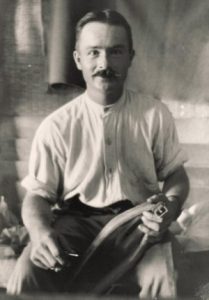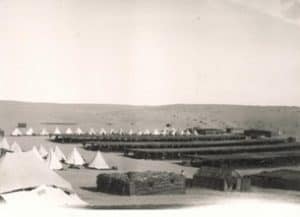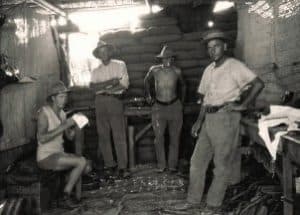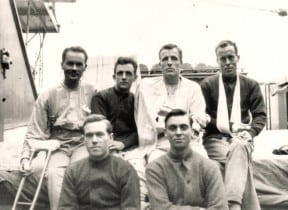HOGDEN, ALBERT HENRY

My grandfather Albert Henry Hogden born 25th April, 1890 in a little town called Cobbera, which was between the Dunedoo and Dubbo (the town no longer exists). He was in the Light Horse Regiment, here is his story taken from my mother’s life story she wrote last year. He was named Albert Henry but for some reason was always called Mac. He had four brothers and two sisters.
Grandpa and Gran Hogden lived on Talbragar station as a manager when they got married. This was on the Castlereagh River near Dunedoo. As Gran told the story to Neil, (my brother) “We picked a good site next to the river, on a bit of high ground, pitched our tent, and in between station work, built a four roomed house or hut. It had a bark roof, cracks in the walls were filled in with mud, we made it pretty comfy, knocked up a bush table, chairs and a bed, and he was pretty handy with his hands, your grandfather.
I think we had 5 or 6 kids in that humpy, before the boss built good quarters about 10 years later. I brought 13 nippers into the world, but only 6 survived, we planted 7 littlies around that old humpy. Gran stopped talking to have a little weep to herself then carried on with her story.
They all went to school for a few years, a little bush school about 4 miles away. When they finished school they worked as boundary riders on the station and as wool-shed hands. Your grandfather decided they had to learn a trade. The girls both got married, George got a job as a fettler on the railways; Charlie was apprenticed to a carpenter and builder in Dunedoo and Gulgong. Your Dad was apprenticed to a saddler in Dunedoo. He was 16 and served his time, and then bought the business when he was 21. He then took young Billie on as an apprentice and they ran the business till W.W.1 broke out in 1914. Billie ran the business while Mac was away. Charlie Mac’s brother joined the flying corp and served as an observer. There were times when I (Mac’s mother) didn’t think your Dad would get back at all from some of the letters we got. Anyhow when they got back they told me they had both put in for Soldiers Settlement blocks between Forbes and Grenfell.
It so happened that they got their blocks almost adjoining, only the lane in between them. Dad of course called his Romani, after an oasis in the desert, which is a place I have seen on a map. Charlie called his Tofua after the ship he came back on. Despite his short years at school Dad was quite a reader, especially in later years when he had time, and he had very good handwriting and managed basic maths.
This is another extract taken from Neil’s story and is Gran Hogden telling how the farm was settled.
“They were told they had drawn blocks of land nearly joining, so they took a train from Gulgong to Grenfell, went out and had a look and they liken them, so we had a real family talk, and your Grandfather and Billie decided to go with them. Your Grandfather was getting on in years and gave up the station job. Your Dad and Charlie were promised government loans to get started, we all went over there. Your Grandfather and Billie had a wagon and team on the station; they used to do carrying around the district when the saddlery business was slack. So we loaded up our chattels what we had and we made over. Dad and Charlie entrained the wagon and the horses to Grenfell, started out to Romani and Tofua from there. Grandpa and Billie and I loaded our things on the wagon and went down by road through Dubbo, Parkes and Forbes. Pitched our tent each night or slept under the wagon.
Grandpa and I went by sulky, made camp and had the billy boiling when Bill came along. Took us 3 to 4 weeks if I remember right. When we got there they started cutting big pine trees off Romani, and some off George and Betty’s, he didn’t want them. (He was a neighbour). Old Jim Flanagan was a bullocky, camped down the end of Pallazzi’s Lane. He took over a sawmill near Pinnacle Mountain. They got all the timber, weatherboards and all for the 2 houses and our little shack from the place and thereabouts. George and Betty just ran a few sheep, he never liked work that bloke. He was a real Pommie Captain! They built a couple of rooms onto an old shepherd’s hut on George’s block on Hill 60. Billie and your Aunty Pat lived up there for a few years.”
As we have seen from Gran’s account, Dad and his brother Charlie had to really start from scratch on the properties. These soldier settlement blocks were cut up from a large station property called Ooma. They were about 1000 acres in area and had no improvements such as fencing, dams, horse yards, sheep yards, cow bails, shearing sheds or any other storage sheds. Some paddocks had to be cleared of excess trees, so that crops could be sown. But Dad made sure some trees were left for stock shelter, when the paddocks were used for grazing in between crops.
They built a 3 roomed cottage first, where they all lived while the house was being built. Up till then they lived in tents. That little house was forever known thereafter as “the cottage”, and wasn’t pulled down till after Mum and Dad left the farm in 1950. My grandparents continued to live there till 1924, just 2 years after my parents’ marriage. I think Gran stayed on for a while after Grandpa’s death, then she divided her time between her 2 daughters, Min and Em, and her 4 sons. She scorned car travel, always going by train, right up until her last years. She probably regaled her fellow passenger with her stories. She was a great talker and had some wonderful yarns of their early days in the bush. Some were very “tall” stories. About the only one I can remember was the one of a 6 foot snake which was curled up in a 2 lb jam tin!
Dad was a gifted man who could turn his hand to just about anything. Apart from his leather work, he could build, and did just about all the mechanical repairs to the car and other machinery on the farm; also for a few neighbours too, much to Mum’s annoyance sometimes, when the jobs on our place were piling up.
He met Mum somewhere in Sydney; sadly I don’t know where or how and there is no one left to ask now. I suspect it was probably when she was working with the V.A.D’s. (Voluntary Aid Detachment). Mum and her good friend Marty (Marcia) Wilkinson decided they wanted to do their bit for the war effort and joined the V.A.D’s.
Mum and Dad were married on 25 March 1922 at St Albans Anglican Church in Epping, Sydney. The following is an extract from his son Neil’s story concerning Dad’s army experiences overseas and after settling on the farm.

Dad aged 25, enlisted at the end of 1914 in the first A.I.F. No 573, and was drafted into the 12th Light Horse Regiment. His initial training was at Holsworthy Army Camp. There he was promoted to Artificer Saddler Sergeant having a staff of 2 privates to maintain saddlery and harness equipment. The unit embarked in Sydney and disembarked in Egypt, there they left their horses with a skeleton staff to feed and water, and generally look after them. The rest of the regiment re-embarked, sailed through the Dardanelle’s landing at Galliopli, a fortnight after the landing – 25th April Dad saw front line action there for 3 months, then was ordered to report to the beach casualty clearing station, under the command of Captain Fenwick. Casualties were very heavy and medical supplies were almost nil. Because he could sew leather and use a needle he was ordered to assist in the stitching up the wounded; a pretty gruesome task for someone without medical experience.
Gangrene was the greatest infection factor, many losing arms and legs on arrival at the base hospitals in Alexandria and Cairo, when they were evacuated from Turkey. Captain Fenwick used to sprinkle raw salt over their wounds which caused shocking pain to the wounded, but later found he had the greatest rate of recovery and the lowest incidents of gangrene of any surgeon on Galliopli. Dad was still there till the evacuation, returning to Egypt with his unit.
There they reclaimed their horses and went into action in Palestine, the first battle being at Romani, but that was only a skirmish. The next battle was at Beersheba, where with fixed bayonets they charged the Turkish trenches galloping over them. The first battle of Gaza was a defeat, whereupon they reformed and went into action against the Turks, which was victorious thus ending the warfare in the Middle East.

It was during the battle for Beersheba that Dad was badly wounded. I can only relate it the way I’ve heard it. They were ordered to attack the Turkish lines, four mounted soldiers in groups of four, galloped out to just short of the Turkish rifle fire, and three dismounted, hit the ground for cover, or advanced, depending on the circumstances. The fourth rider was to lead the horses back to the initial position. Dad the Saddlery Sgt. Of the Day, casualties were pretty heavy, one trooper came back badly wounded, collapsing off his horse, three troopers were ready to gallop out but no one to bring back the horses. So he jumped on his horse and rode out to bring the horses back, ordered not to but ignored the order. They were almost to the point of dismounting when a Turkish machine gun opened up and his horse was shot from under him. He received a bullet in the low abdomen, right side, the bullet lodged against the femur joint, turning horizontally against the bone. He managed to crawl to his dead horse, sheltering behind it and to retrieve his water bottle from the saddle.
Remembering the effect of the salt tablets on Galliopli – they were issued with a calico bag of salt tablets; he moistened one in his mouth and pushed it into his wound. The rest, about a dozen or so, he put into his water bottle. Each time he came to, he sipped the salt water. He lay in the blazing desert sun from about 9.00 am till late evening, when both sides raised white flags to retrieve wounded and bury the dead. He just recalls being thrown into a Red Cross lumber wagon, which had galloped out. The next thing he knew was waking up in Alexandria Base Hospital. The doctors told him that it was only using salt tablets in such a way that saved his life. He was hospitalised there for a couple of months early in 1917.
Then he was put onto a hospital ship to sail home, but at Bombay, doctors decided he had little chance of making it back to Australia. There he was put on a British hospital train and thence to the British hospital in Agra . He was hospitalised there for many months, recovering from wheelchair to crutches, and walked off the boat on return to Sydney in 1918

During his months of convalescence, he was befriended by the Maharaja of the Province. He lived in a huge palatial castle with a multitude of servants, wealthy to an unknown extent. Dad was taken there and was given special Indian herbs and potions to assist in his recovery. This definitely helped him a great deal, so much so that he walked onto the ship bringing him home and off again in Sydney.
Dad seems to have spent some time in Sydney after his discharge judging from some old photos in his collection. Sadly there is no information on the back to tell us who or what they are. He may have been waiting for a Soldier Settlement block of land that he applied for.
Here there is a difference in records. Neil says he was discharged as A1, but the copy of his discharge papers I have says he was discharged as medically unfit. Nevertheless, he was well enough to take on the farm, and it wasn’t until about 1930 that the bullet moved and began to give him much pain. About 1939 he became virtually bed ridden and suffered terrible nightmares. Dr Reading who lived at a nearby property, would come over and visit him, and told him that in his opinion the bullet had either moved or was moving.
He rang the Repatriation Department in Sydney and arranged for a Sister to accompany him by ambulance to Randwick Military Hospital. By this time he was just skin and bone. He was x-rayed on arrival and it was found that the bullet had moved nearly 4 inches and was just half an inch under the skin on the left thigh.
Previously on a number of occasions it was considered to be absolutely inoperable. It was removed on 14/3/1940. Following that he made a good recovery and with help from good neighbours carried on the farm during the war years. Dad carried that bullet around for 23 years, when it was removed he had a small leather box made for it and carried it around in that for some years.
Marion Wattam 2004
| Regimental number | 573 |
| Religion | Church of England |
| Occupation | Station hand |
| Address | c/o W E Hogden, Dunnedoo, New South Wales |
| Marital status | Single |
| Age at embarkation | 24 |
| Next of kin | Brother, William E Hogden, Dunedoo, New South Wales |
| Enlistment date | 16 December 1914 |
| Rank on enlistment | Sergeant (Saddler) |
| Unit name | 12th Light Horse Regiment, Headquarters |
| AWM Embarkation Roll number | 10/17/1 |
| Embarkation details | Unit embarked from Sydney, New South Wales, on board HMAT A29 Suevic on 13 June 1915 |
| Rank from Nominal Roll | Sergeant |
| Unit from Nominal Roll | 12th Light Horse Regiment |
| Returned to Australia 11 July 1917 |
